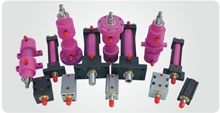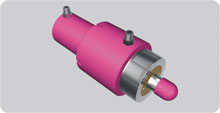Hydraulic Cylinders manufacturer
Qualified hydraulic cylinder with enconomical costs
www.hc-hydraulic-cylinder.com
Hydraulic cylinder researching + hydraulic cylinder developing
HC has the very strong hydraulic cylinder researching and developing ability for hydraulic cylinder design and manufacturing, during the past more than 10 years experience and researching on the hydraulic cylinder, HC has established company standard of design, machining process standard pressure formula. Due to the experience in design, machining and quality controlling, HC hydraulic cylinder has met all kinds of hydraulic cylinder and also have met all kinds of blind area of quality. The followings are describing to HC experience and technologies knowledge for hydraulic cylinders' design, manufacturing and developing.
Due to the hydraulic cylinder's moving is directly, it is only for pushing or pulling, there should be one bending or curves surface in the barrel or in the piston rod. For this reason, the hydraulic cylinder should be used for pushing and pulling only. No bending moments or side loads should be transmitted to the piston rod or the cylinder. For this reason, the ideal connection of the hydraulic cylinder should be a single ring with a special ball bearing. In this way, the hydraulic cylinder can move without any miss-alignment between the actuator and the loaded components during the pulling or pushing.
Hydraulic Cylinder Designs
There are mainly two styles of hydraulic cylinder designs used:
- Tie rod type hydraulic cylinders
- Welded body type hydraulic cylinders
Tie rod type hydraulic cylinders
Tie rod style hydraulic cylinders use high strength threaded steel rods to hold the two end caps to the cylinder barrel. This method of construction is most often seen in industrial factory applications. Small bore cylinders usually have 4 tie rods, while large bore cylinders may require as many as 16 or 20 tie rods in order to retain the end caps under the tremendous forces produced. Tie rod style cylinders can be completely disassembled for service and repair.
The National Fluid Power Association (NFPA) has standardized the dimensions of hydraulic tie rod cylinders. This enables cylinders from different manufacturers to interchange within the same mountings.
Welded body type hydraulic cylinders
Welded body cylinders have no tie rods. The barrel is welded directly to the end caps. The ports are welded to the barrel. The front rod gland is usually threaded into or bolted to the cylinder barrel. This allows the piston rod assembly and the rod seals to be removed for service.
A Cut Away of a Welded Body Hydraulic Cylinder showing the internal components
Welded body cylinders have a number of advantages over tie rod style cylinders. Welded cylinders have a narrower body and often a shorter overall length enabling them to fit better into the tight confines of machinery. Welded cylinders do not suffer from failure due to tie rod stretch at high pressures and long strokes. The welded design also lends itself to customization. Special features are easily added to the cylinder body. These may include special ports, custom mounts, valve manifolds, and so on.
The smooth outer body of welded cylinders also enables the design of multi-stage telescopic cylinders.
Welded body hydraulic cylinders dominate the mobile hydraulic equipment market such as construction equipment (excavators, bulldozers, and road graders) and material handling equipment (forklift trucks and lift-gates). They are also used in heavy industry such as cranes, oil rigs, and large off-road vehicles in above-ground mining.
Hydraulic cylinder Piston Rod construction
The piston rod of a hydraulic cylinder operates both inside and outside the barrel, and consequently both in and out of the hydraulic fluid and surrounding atmosphere.
Metallic coatings
Smooth and hard surfaces are desirable on the outer diameter of the piston rod and slide rings for proper sealing. Corrosion resistance is also advantageous. A chromium layer may often be applied on the outer surfaces of these parts. However, chromium layers may be porous, thereby attracting moisture and eventually causing oxidation. In harsh marine environments, the steel is often treated with both a nickel layer and a chromium layer. Often 40 to 150 micrometer thick layers are applied. Sometimes solid stainless steel rods are used. High quality stainless steel such as AISI 316 may be used for low stress applications. Other stainless steels such as AISI 431 may also be used where there are higher stresses, but lower corrosion concerns.
Ceramic coatings
Due to shortcomings of metallic materials, ceramic coatings were developed. Initially ceramic protection schemes seemed ideal, but porosity was higher than projected. Recently the corrosion resistant semi ceramic Lunac 2+ coatings were introduced. These hard coatings are non porous and do not suffer from high brittleness.
Lengths
Piston rods are generally available in lengths which are cut to suit the application. As the common rods have a soft or mild steel core, their ends can be welded or machined for a screw thread.
Special hydraulic cylinders
Telescopic cylinder
Telescopic cylinder (ISO 1219 symbol)The length of a hydraulic cylinder is the total of the stroke, the thickness of the piston, the thickness of bottom and head and the length of the connections. Often this length does not fit in the machine. In that case the piston rod is also used as a piston barrel and a second piston rod is used. These kind of cylinders are called telescopic cylinders. If we call a normal rod cylinder single stage, telescopic cylinders are multi-stage units of two, three, four, five and even six stages. In general telescopic cylinders are much more expensive than normal cylinders. Most telescopic cylinders are single acting (push). Double acting telescopic cylinders must be specially designed and manufactured.
Plunger cylinder
A hydraulic cylinder without a piston or with a piston without seals is called a plunger cylinder. A plunger cylinder can only be used as a pushing cylinder; the maximum force is piston rod area multiplied by pressure. This means that a plunger cylinder in general has a relatively thick piston rod.
Differential cylinder
Differential cylinder (ISO 1219 symbol)A differential cylinder acts like a normal cylinder when pulling. If the cylinder however has to push, the oil from the piston rod side of the cylinder is not returned to the reservoir, but goes to the bottom side of the cylinder. In such a way, the cylinder goes much faster, but the maximum force the cylinder can give is like a plunger cylinder. A differential cylinder can be manufactured like a normal cylinder, and only a special control is added.
Rephasing cylinder
Rephasing cylinders are two or more cylinders plumbed in series or parallel, with the bores and rods sized such that all rods extend and/or retract equally when flow is directed to the first, or last, cylinder within the system.
In "parallel" applications, the bore and rod sizes are always the same, and the cylinders are always used in pairs. In "series" applications, the bore and rod sizes are always different, and two or more cylinders may be used. In these applications, the bores and rods are sized such that all rods extend or retract equally when flow is applied to the first or last cylinder within the system.
This hydraulic synchronization of rod positions eliminates the need for a flow divider in the hydraulic system, or any type of mechanical connection between the cylinder rods to achieve synchronization.
Position sensing "smart" hydraulic cylinder
Position sensing hydraulic cylinders eliminate the need for a hollow cylinder rod. Instead, an external sensing “bar” utilizing Hall-Effect technology senses the position of the cylinder’s piston. This is accomplished by the placement of a permanent magnet within the piston. The magnet propagates a magnetic field through the steel wall of the cylinder, providing a locating signal to the sensor.
A note about popular terminology
At least in the USA, popular usage sometimes refers to the whole assembly of cylinder, piston, and piston rod (or more) collectively as a "piston", which is incorrect. See, for instance, "Hydraulic piston raises the table from 19 to 26".











